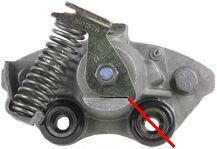Well I've searched the forum... and the first lesson I learned is to cope with American English as well as British English! Very important when you try to search for stuff. That explains the title of this post. I know about brake rotors (we call them discs); and trunk (US) = boot (UK); hood (US) = bonnet (UK). Now, what we call the handbrake over on this side of the Atlantic seems to be known in the US as the e-brake (e meaning emergency, not electronic!) or the parking brake.
OK, enough of the linguistic technicalities. Here's the question. How to adjust the e-brake/handbrake on an 88-model Fiero? I have searched the forum, and there's lots of advice, and warnings, about the 84-87 set-up. Because that system uses the e-brake to adjust the rear calipers/pads, the setting or adjusting of the ebrake is critical. The Ogre's Cave article at
http://home.comcast.net/~fierocave/brakes2.htm seems to explain pretty well how to adjust the 84-87 system.
In what ways does the 1988 e-brake setup differ? More specifically, can anyone give me a step-by-step guide to adjusting or setting the e-brake (handbrake) on an '88? Can it be done separately and independently of fitting/adjusting the rear calipers? Do the instructions in the Carquest guide at
http://www.carquest.com/com...tsTechBrakeT1008.pdf apply to the 88 Fiero setup?
I have to ask the basic questions because my mechanic friend, who has just overhauled the brake system and replaced the pads and all the pipes and hoses (UK) = brake lines (US!), has never worked on a Fiero before, and mine is the only one he is ever likely to see. So we need detailed advice which allows for the fact that we have no previous experience of these weird GM brake systems.
We Fiero owners might be crazy, but at least we're dedicated!
br1anstorm



















